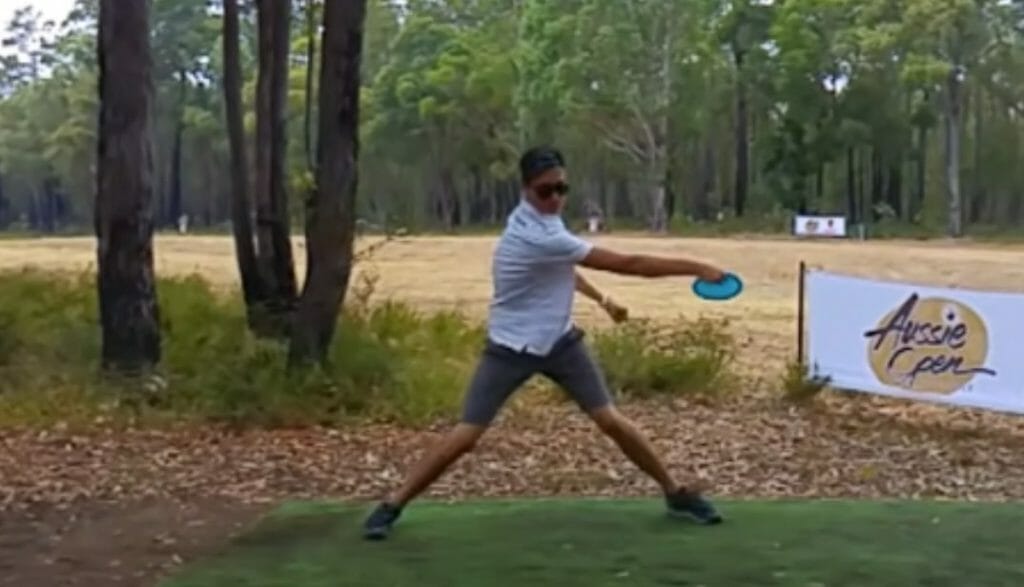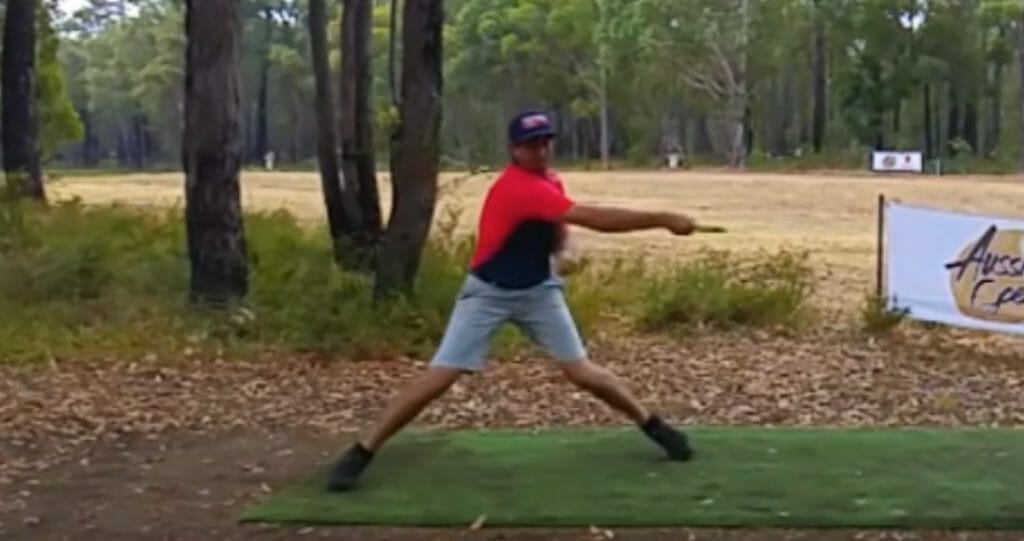"Slow down" means something specific.
August 9, 2022 by Steve Andrews in Instruction, Opinion with 0 comments
One of the most common recommendations for throwing better shots is “slow down.” The hard thing is that slowing down isn’t easy, and it doesn’t always work. Slowing down every part of your swing feels like abandoning distance and, worse, that loss of distance often comes with no gains in accuracy. Sometimes, you feel like you’ve lost your natural rhythm with no upside.
It’s probably true that most amateur players need to slow down their x-step, but the goal is not to slow down for its own sake, but to find a speed that works best for you. It’s not just about going slow but being able to get your mechanics to hold up when you go faster. The real goal is to find your perfect speed, a tempo that works with your timing and generates your best combination of power and accuracy.
How Tempo Affects Timing
When I talk about timing, I mean how the parts of your body work together to generate force and then move that force into your throw. As you move into the shot and wind up your body, you are producing potential energy. Then, as you swing forward, you try and get that energy into your disc. All your joints and levers move that energy through the system, and when it is done efficiently, you get a high percentage of that potential energy into the shot.
The potential energy available is partly determined by your body shape and fitness – How long are your levers? How good is your flexibility and strength? – and some is set by technique. This is where good positions and mechanics come into play. If you have an efficient swing and don’t round, spin out, or reroute the disc, you can preserve a lot of that energy and get a powerful throw. The best players often have gifts in both departments – long levers, good flexibility and strength, clean technique. They can generate a lot of energy and then get it efficiently into the disc. For players who don’t have the benefit of generating a lot of potential power, for example, those of us who aren’t gifted with a wide wingspan and great flexibility, preserving the power we can create is essential.
Think of Paige Pierce. She is smaller than nearly every adult male player in the country, but she is strong and fast, and her beautiful form makes sure that she gets almost all the power she generates into the disc.
Unlike for Pierce, the problem for most amateurs is that bad positions, inefficient timing, and flawed tempo produces power leaks that can result in putting very little energy into your throw.
Imagine this energy in the system is moving from joint to joint like a baton being passed between runners in a relay race. If each pass is done smoothly and efficiently, the race is run well. But there are lots of places where this can go wrong. If tight or weak muscles can’t move quickly or the way you need, you don’t efficiently shift your weight, or you start your shoulders before your hips, you lose all the energy you created in your turn and backswing. Essentially a runner on your relay team dropped the baton or left their blocks before it ever got to them.
This is the challenge of a technique-heavy sport like disc golf. It is not just about doing the right thing. It is about doing the right thing at the right time.
This is also the main problem with going too fast. As most players accelerate their tempo, they lose the ability to fire everything in the proper sequence. Going quicker can add more potential power in the system, but if you don’t get that energy into the disc, that power is wasted.
It is important to have good positions and develop mechanics that help your swing be efficient, but even if you have good positions, going too fast can ruin them. The usual suggestion to this problem is to slow down and bring your tempo down to a level where your mechanics can work efficiently.
That is good advice – but how do we slow down? While slowing the whole swing down can help your sequencing, it is hard to get good distance if you slow everything down to a crawl. You are transferring the power in your swing more efficiently, but there just isn’t enough energy in the system. Lots of players who try to “slow down” abandon it when they become frustrated by a loss of distance.
A crucial moment is the final step of your x-step. This is where the bill of going too fast often comes due. When you go quickly, the lead foot often winds up under your lead shoulder. Your speed exceeds your ability to brace your front foot and you roll over your brace, leading to spinning out, falling back, or stumbling off the teepad.
This may be hard to envision, so I made a short video explaining what I mean:
Even if you are throwing at a speed you can handle, the tempo of that final step can throw you off. I have found that the normal, consistent tempo of this final step often produces a short final step that feels fine but results in a weak brace because the front shoulder is even with, or even ahead of, the lead foot. This makes it hard to get a good coil or get your body into the shot.
The Power of “Broken” Tempo
A solution that has helped me is to feel a tempo change as I come into that last step. Instead of an even tempo of 1, 2, 3, 4 – in which you are moving through with each step following at a steady (or even accelerating!) pace, try 1,2,3…4 – a purposeful lengthening of that last step to give your body time to reach forward with your lead foot. This will give you a stronger base and make sure your lead shoulder is behind your lead foot. In field work, I will literally say “1,2,3…stride.”
This small change generates a lot of benefits. Not only do you get in a better shoulder/foot position, but this longer stride also demands that your weight be settled on your back leg as you go into your weight shift. You can’t smoothly reach that foot forward if it’s bearing weight. This helps your coil. As you incorporate this timing, you will feel your energy being held in your back leg and then shifting like a pitcher going from the single leg position at the top of his windup into a stride towards home plate.
It also helps address the question of how to “go slow.” Start with putters or midranges at a speed that allows you to really feel that smooth elongation of your stride step. Once you can feel it, you can add speed. As long as you can maintain this tempo break efficiently at a quicker tempo, that’s fine. You don’t have to drain all the speed out of your throw if you can hold your balance and timing coming into that final step. Just make sure you can feel yourself gathering power before you stride.
This stride position is very clear in the throws of top pros. In many players it produces the kind of “pyramid” shape just as they shift their weight. Here are both Eagle McMahon and Paul McBeth at the Australian Open:


Having this long stride step gives them lots of time and room to shift their weight into their firmly braced front foot.
But remember, these guys are very strong, very flexible, and have been doing this a long time. You may not be able to get into this very long stride position. That’s fine. If you are like many players, you have been moving too fast and essentially falling out of your x-step to catch yourself with a short final step. Changing that tempo, even if it starts out as just a small stride, will pay dividends in power and accuracy.
Seeing this Tempo on Tour
This delayed stride tempo works great on both drives and controlled shots. However, it is sometimes hard to see in the full throws of pros, as their ability to go very fast while keep the sequencing of their swing is part of what makes them professionals. However, you can spot it in some of players with the best form in the game. In this shot by Valerie Mandujano, for example, you can see the delay as she goes into her final stride step and then throws with perfect balance.
Often, this stride tempo is more apparent when players are throwing approaches and controlled shots. Here is Paul McBeth throwing a perfect shot on a short hole at Milo McIver. You can see the slowing of his tempo as he goes into his final step.
This shot from Lizotte at the 2022 European Open during his second round is even clearer. Here he is on the fifth tee, look at the change of tempo as he goes into his final stride, resulting in a shot that trickles right in front of the basket.
Throughout the round, you can see Lizotte settling into that smooth final step. You can almost feel the power “settling” into the shot as he glides into his stride:
If you have been struggling with these issues – having your form collapse or trying to slow down without really knowing how – then try this offset tempo. Start at slow speeds with putters and mids and really feel that sensation of settling into a comfortable stride. I think it will help your game.